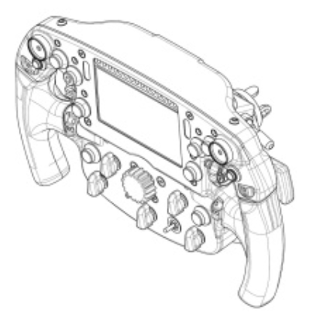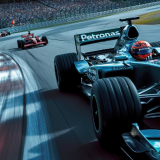The F1 season kicks off on March 2, 2024. Formula 1 stands as the pinnacle of single-seater auto racing sanctioned by the Fédération Internationale de l’Automobile (FIA). The first race of this season will take place in Bahrain, where Mercedes, RedBull Racing, McLaren, Aston Martin, Ferrari and the other F1 teams will begin to compete for the 2024 world championship.
The domain of Formula 1, marked by state-of-the-art technology and intense rivalry, heavily depends on Intellectual Property for the preservation and augmentation of innovations in automotive technology. The captivating realm of Formula 1 racing intertwines seamlessly with the intricate landscape of Intellectual Property rights. As teams vie for supremacy on the track, they navigate a strategic dance of safeguarding innovations through various Intellectual Property (IP) rights. In this high-stakes arena, where speedand entertainment meet innovation, the fusion of IP and technological advancement underscores the pivotal role of IP in motorsports.
This article discusses the nexus between F1 and intellectual property strategies in the realm of high-performance motorsports while delving into the multifaceted landscape of IP rights, including trade secrets, industrial designs, trademarks, and patents.
Trade Secrets in the Fast Track
Formula One isn't just about speed. It's a hotbed of innovation, driven by data and pushing automotive boundaries. Teams vie for victory by constantly refining their engine technology, knowing it's the key to championship success. Even the smallest advancements can make the difference between triumph and mediocrity. Trade secrets play a crucial role, and Formula One teams use them to maintain competitive advantages over competitors.
Trade secrets are intellectual property rights that protect confidential information, which furnishes a commercial edge. Generally speaking, to be classified as a trade secret, the information typically must meet certain criteria: (1) it holds commercial value due to its secrecy. (2) It is known solely by a restricted group of people. (3) The rightful holder has taken reasonable measures to maintain its secrecy, often including confidentiality agreements with business partners and employees, as well as technological and physical measurements that are taken to ensure the information is not accessible to others. Unauthorized acquisition, use, or disclosure of such information, contrary to honest commercial practices, constitutes an unfair practice and a breach of trade secret protection. Hence, a trade secret safeguards valuable commercial information and has been shown to protect the technology of the teams to a certain extent.
Nevertheless, relying on trade secrets poses risks, as there is a potential for information to be lost or stolen. Take for instance the "Spygate" case – one of the largest cases of trade secrets in Formula One. Ferrari launched an investigation and sued McLaren after it was discovered that a former Ferrari technical manager had leaked confidential information. This included details of Ferrari's budget, engine specifications, technical reports, and allegations of cheating in the 2006 Australian Grand Prix. The leaked documents also contained extensive information about Ferrari's 2007 F1 car, resulting in McLaren being fined USD 100 million (!) and excluded from the 2007 Constructors' World Championship.
Proving leaks of confidential information can be challenging. , and may require, as the Spygate case shows, an extensive investigation. The mere fact that an opponent uses the confidential information is not sufficient. Trade secret law (as well as FIA regulations) stipulates that reverse engineering is fair game. If the technological innovation can be reverse-engineered – proving misappropriation of the trade secret is not as easy as simply showing the other party implemented the innovation for their benefit. Nonetheless, the importance of trade secrets as a fundamental aspect of the IP strategy in Formula 1 is undeniable.
Crafting Speed - Industrial Designs in Formula 1
Formula One is not just a race, but is one of the world’s most known entertainment arenas, with millions of fans around the globe. The industrial designers and engineers of Formula One teams invest significantly in crafting every aspect of the cars, down to the tiniest details, for the crowd to enjoy, applaud, and buy. To protect the unique visual features of F1 cars or specific components, teams can opt for industrial design registration. This type of intellectual property covers the three-dimensional shapes used as manufacturing templates, without significant technical impact.
Legally, an industrial design refers to the ornamental aspect of an item, which can include three-dimensional features, like the shape of an article, or two-dimensional features, like patterns, lines, or color. Essentially, owners of registered industrial designs have the right to prevent others from making, selling, or importing articles that closely resemble their protected designs for commercial purposes.
Beyond preserving the visual appeal of the car, industrial design registration enables teams to leverage their unique designs in various commercial endeavors, such as producing toy cars and other merchandise.
For instance, Ferrari had registered designs for racing steering wheel for car or toy car. The following is a figure from Ferrari’s U.S. design registration (D867237):

Another example is McLaren’s European Union registration protecting their coloring scheme on a racing car (EM 008917926):

Therefore, Industrial design registration protects the distinctive appearance of F1 cars and enable commercialization beyond racing.
Branding the Fast Lane - Trademark Insights from Formula 1
Formula One, first and foremost, is a business. It sells, like any sport entertainment, excitement, pride, and joy. To create such a connection Formula One and the teams need to establish well recognizable identities with their fans – their brands. Brands are protected through the use of trademarks. A Trademark is a legally protected sign, symbol, logo, phrase, word, design, or similar indication that identifies and distinguishes the source of goods or services of one party from those of others. A trademark provides exclusive rights to its owner to use the mark in commerce in connection with specific goods or services. This exclusivity allows the owner to prevent others from using a confusingly similar mark that could lead to consumer confusion about the origin of goods or services. The reputation of F1 hinges on its name, logo, and brand value. Over the years, F1 has effectively cultivated this reputation, with its championship history intertwined with iconic trademarks such as the F1 logos, F1 FORMULA 1 logos, F1 FIA FORMULA 1 WORLD CHAMPIONSHIP logo - ,
,  ,
,  , FORMULA 1, FORMULA ONE, F1, FIA FORMULA ONE WORLD CHAMPIONSHIP, and other associated marks, all registered trademarks of Formula One. Formula One Group maintains a comprehensive collection of registered trademarks, highlighting the importance of brand identity and safeguarding within the realm of motorsport.
, FORMULA 1, FORMULA ONE, F1, FIA FORMULA ONE WORLD CHAMPIONSHIP, and other associated marks, all registered trademarks of Formula One. Formula One Group maintains a comprehensive collection of registered trademarks, highlighting the importance of brand identity and safeguarding within the realm of motorsport.
Trademark protection plays a pivotal role in Formula One, extending beyond team names (Red Bull RACING ®, W WILLIAMS RACING ®) to cover drivers (Lewis Hamilton ®, Max Verstappen ®), tracks (MONACO GRAND PRIX ®, LAS VEGAS GRAND PRIX ®), and even distinctive unique celebrations (SHOEY ® - drinking champagne out of racing boot on the podium).
As can be seen, trademarks are integral to Formula One, serving as vital intellectual property assets. They define the visual identity of teams, drivers, and events, enabling brand recognition and fostering lucrative partnerships. In the dynamic world of motorsport, trademarks are indispensable, emblematic of Formula One's global prominence and enduring legacy.
Lack of Patents Sparks Competitive Fervor
In the world of Formula One, the engine reigns supreme, offering a competitive edge that can determine victory by mere seconds. Therefore, safeguarding the innovation, technology, and design of this pivotal component through intellectual property (IP) protection becomes paramount. However, unlike industries such as telecommunications and pharmaceuticals, where patent protection is standard practice, Formula One operates differently.
The absence of patents in Formula One stems from its competitive nature. Imagine a scenario: a team develops a groundbreaking engine technology, shaving off crucial seconds and securing a significant advantage over rivals. If they were to patent this innovation, it would undoubtedly be challenged and potentially nullified through the FIA process by season’s end. This regulation ensures a level playing field, preventing one team from monopolizing technological advancements and maintaining the integrity of the competition.
In essence, while patents may seem like a logical means of protecting technical innovations, the unique dynamics of Formula One, as well as the specific details of the regulating authority, FIA, render them impractical and counterproductive. Instead, the sport relies on regulations and the spirit of competition to drive innovation and ensure fairness among teams on the race track.
As described in this article, the integral role of Intellectual Property within the milieu of Formula One emerges as a substantial consideration. It is discernible that Intellectual Property serves as a linchpin for fostering innovation, protecting valuable assets, and shaping the commercial landscape of the sport. The strategic management and enforcement of Intellectual Property rights not only safeguards the proprietary interests of teams and the management but also underpins the economic viability and global prominence of Formula One. Intellectual Property stands as a cornerstone in the perpetuation and advancement of Formula One, emblematic of its enduring legacy and dynamic evolution within the realm of high-performance motorsports.
The domain of Formula 1, marked by state-of-the-art technology and intense rivalry, heavily depends on Intellectual Property for the preservation and augmentation of innovations in automotive technology. The captivating realm of Formula 1 racing intertwines seamlessly with the intricate landscape of Intellectual Property rights. As teams vie for supremacy on the track, they navigate a strategic dance of safeguarding innovations through various Intellectual Property (IP) rights. In this high-stakes arena, where speedand entertainment meet innovation, the fusion of IP and technological advancement underscores the pivotal role of IP in motorsports.
This article discusses the nexus between F1 and intellectual property strategies in the realm of high-performance motorsports while delving into the multifaceted landscape of IP rights, including trade secrets, industrial designs, trademarks, and patents.
Trade Secrets in the Fast Track
Formula One isn't just about speed. It's a hotbed of innovation, driven by data and pushing automotive boundaries. Teams vie for victory by constantly refining their engine technology, knowing it's the key to championship success. Even the smallest advancements can make the difference between triumph and mediocrity. Trade secrets play a crucial role, and Formula One teams use them to maintain competitive advantages over competitors.
Trade secrets are intellectual property rights that protect confidential information, which furnishes a commercial edge. Generally speaking, to be classified as a trade secret, the information typically must meet certain criteria: (1) it holds commercial value due to its secrecy. (2) It is known solely by a restricted group of people. (3) The rightful holder has taken reasonable measures to maintain its secrecy, often including confidentiality agreements with business partners and employees, as well as technological and physical measurements that are taken to ensure the information is not accessible to others. Unauthorized acquisition, use, or disclosure of such information, contrary to honest commercial practices, constitutes an unfair practice and a breach of trade secret protection. Hence, a trade secret safeguards valuable commercial information and has been shown to protect the technology of the teams to a certain extent.
Nevertheless, relying on trade secrets poses risks, as there is a potential for information to be lost or stolen. Take for instance the "Spygate" case – one of the largest cases of trade secrets in Formula One. Ferrari launched an investigation and sued McLaren after it was discovered that a former Ferrari technical manager had leaked confidential information. This included details of Ferrari's budget, engine specifications, technical reports, and allegations of cheating in the 2006 Australian Grand Prix. The leaked documents also contained extensive information about Ferrari's 2007 F1 car, resulting in McLaren being fined USD 100 million (!) and excluded from the 2007 Constructors' World Championship.
Proving leaks of confidential information can be challenging. , and may require, as the Spygate case shows, an extensive investigation. The mere fact that an opponent uses the confidential information is not sufficient. Trade secret law (as well as FIA regulations) stipulates that reverse engineering is fair game. If the technological innovation can be reverse-engineered – proving misappropriation of the trade secret is not as easy as simply showing the other party implemented the innovation for their benefit. Nonetheless, the importance of trade secrets as a fundamental aspect of the IP strategy in Formula 1 is undeniable.
Crafting Speed - Industrial Designs in Formula 1
Formula One is not just a race, but is one of the world’s most known entertainment arenas, with millions of fans around the globe. The industrial designers and engineers of Formula One teams invest significantly in crafting every aspect of the cars, down to the tiniest details, for the crowd to enjoy, applaud, and buy. To protect the unique visual features of F1 cars or specific components, teams can opt for industrial design registration. This type of intellectual property covers the three-dimensional shapes used as manufacturing templates, without significant technical impact.
Legally, an industrial design refers to the ornamental aspect of an item, which can include three-dimensional features, like the shape of an article, or two-dimensional features, like patterns, lines, or color. Essentially, owners of registered industrial designs have the right to prevent others from making, selling, or importing articles that closely resemble their protected designs for commercial purposes.
Beyond preserving the visual appeal of the car, industrial design registration enables teams to leverage their unique designs in various commercial endeavors, such as producing toy cars and other merchandise.
For instance, Ferrari had registered designs for racing steering wheel for car or toy car. The following is a figure from Ferrari’s U.S. design registration (D867237):

Another example is McLaren’s European Union registration protecting their coloring scheme on a racing car (EM 008917926):

Therefore, Industrial design registration protects the distinctive appearance of F1 cars and enable commercialization beyond racing.
Branding the Fast Lane - Trademark Insights from Formula 1
Formula One, first and foremost, is a business. It sells, like any sport entertainment, excitement, pride, and joy. To create such a connection Formula One and the teams need to establish well recognizable identities with their fans – their brands. Brands are protected through the use of trademarks. A Trademark is a legally protected sign, symbol, logo, phrase, word, design, or similar indication that identifies and distinguishes the source of goods or services of one party from those of others. A trademark provides exclusive rights to its owner to use the mark in commerce in connection with specific goods or services. This exclusivity allows the owner to prevent others from using a confusingly similar mark that could lead to consumer confusion about the origin of goods or services. The reputation of F1 hinges on its name, logo, and brand value. Over the years, F1 has effectively cultivated this reputation, with its championship history intertwined with iconic trademarks such as the F1 logos, F1 FORMULA 1 logos, F1 FIA FORMULA 1 WORLD CHAMPIONSHIP logo -
 , FORMULA 1, FORMULA ONE, F1, FIA FORMULA ONE WORLD CHAMPIONSHIP, and other associated marks, all registered trademarks of Formula One. Formula One Group maintains a comprehensive collection of registered trademarks, highlighting the importance of brand identity and safeguarding within the realm of motorsport.
, FORMULA 1, FORMULA ONE, F1, FIA FORMULA ONE WORLD CHAMPIONSHIP, and other associated marks, all registered trademarks of Formula One. Formula One Group maintains a comprehensive collection of registered trademarks, highlighting the importance of brand identity and safeguarding within the realm of motorsport. Trademark protection plays a pivotal role in Formula One, extending beyond team names (Red Bull RACING ®, W WILLIAMS RACING ®) to cover drivers (Lewis Hamilton ®, Max Verstappen ®), tracks (MONACO GRAND PRIX ®, LAS VEGAS GRAND PRIX ®), and even distinctive unique celebrations (SHOEY ® - drinking champagne out of racing boot on the podium).
As can be seen, trademarks are integral to Formula One, serving as vital intellectual property assets. They define the visual identity of teams, drivers, and events, enabling brand recognition and fostering lucrative partnerships. In the dynamic world of motorsport, trademarks are indispensable, emblematic of Formula One's global prominence and enduring legacy.
Lack of Patents Sparks Competitive Fervor
In the world of Formula One, the engine reigns supreme, offering a competitive edge that can determine victory by mere seconds. Therefore, safeguarding the innovation, technology, and design of this pivotal component through intellectual property (IP) protection becomes paramount. However, unlike industries such as telecommunications and pharmaceuticals, where patent protection is standard practice, Formula One operates differently.
The absence of patents in Formula One stems from its competitive nature. Imagine a scenario: a team develops a groundbreaking engine technology, shaving off crucial seconds and securing a significant advantage over rivals. If they were to patent this innovation, it would undoubtedly be challenged and potentially nullified through the FIA process by season’s end. This regulation ensures a level playing field, preventing one team from monopolizing technological advancements and maintaining the integrity of the competition.
In essence, while patents may seem like a logical means of protecting technical innovations, the unique dynamics of Formula One, as well as the specific details of the regulating authority, FIA, render them impractical and counterproductive. Instead, the sport relies on regulations and the spirit of competition to drive innovation and ensure fairness among teams on the race track.
As described in this article, the integral role of Intellectual Property within the milieu of Formula One emerges as a substantial consideration. It is discernible that Intellectual Property serves as a linchpin for fostering innovation, protecting valuable assets, and shaping the commercial landscape of the sport. The strategic management and enforcement of Intellectual Property rights not only safeguards the proprietary interests of teams and the management but also underpins the economic viability and global prominence of Formula One. Intellectual Property stands as a cornerstone in the perpetuation and advancement of Formula One, emblematic of its enduring legacy and dynamic evolution within the realm of high-performance motorsports.
















